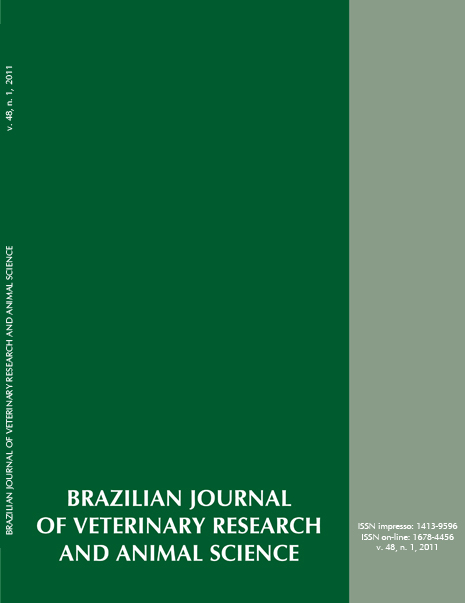17β-estradiol alters endometrial protein expression in bovine females treated at the 17th day of estrous cycle
DOI:
https://doi.org/10.11606/S1413-95962011000100004Keywords:
Bovine, Estradiol, Luteolysis, Prostaglandin F2α,Abstract
In bovine females the release of prostaglandin F2α (PGF2α) is induced in vivo by estradiol (E2). It is believed that E2 stimulates the synthesis of essential proteins for the production of PGF2α. This study aimed to evaluate the effect of E2 in increasing the concentration of total protein and modifying the protein composition of endometrial explants from bovine females treated with E2 at the 17th day of estrous cycle. Crossbred heifers were treated at 17th day of estrous cycle intravenously with 0 mg (Control Group; n = 6) or 3 mg of E2 (E2 Group; n = 6) and killed two hours after. Endometrial explants were isolated, subjected to extraction of total protein, quantified and were analyzed by one-dimensional electrophoresis on polyacrylamide gel 10% SDS-PAGE. The concentration of total protein did not differ between groups, 6296.10 + 439.90 µg/mL for the Control Group and 8426.56 + 1156.00 µg/mL for E2 Group (p = 0.1158). There was no significant difference (p > 0.05) in the protein profile of endometrial explants in gels stained with Coomasie Blue. In gels stained with Silver Nitrate it was verified in E2 Group greater relative percentage of the bands referring to the molecular weight of 75 to 76 kDa (8.40% vs. 4.89% in E2 Group and Control respectively; p < 0.05) and 108 to 110 Kda (6.85% vs. 3.84% in E2 Group and Control respectively, p < 0.05). It was observed in E2 Group lower relative percentage of the band referring to the molecular weight of 90 kDa (5.78% vs. 9.83% in E2 Group and control respectively; p < 0.05). We concluded that the E2 does not increase the protein concentration in the endometrium, however, it modifies the proteinic composition in the endometrial explants, indicating that E2 alters the expression of specific proteins.Downloads
Downloads
Published
2011-02-01
Issue
Section
UNDEFINIED
License
The journal content is authorized under the Creative Commons BY-NC-SA license (summary of the license: https://
How to Cite
1.
Alves Junior SS, Castro FC de, Soares N, Pereira FTV, Balieiro JC de C, Munin FS, et al. 17β-estradiol alters endometrial protein expression in bovine females treated at the 17th day of estrous cycle. Braz. J. Vet. Res. Anim. Sci. [Internet]. 2011 Feb. 1 [cited 2025 Apr. 5];48(1):27-3. Available from: https://revistas.usp.br/bjvras/article/view/34373





